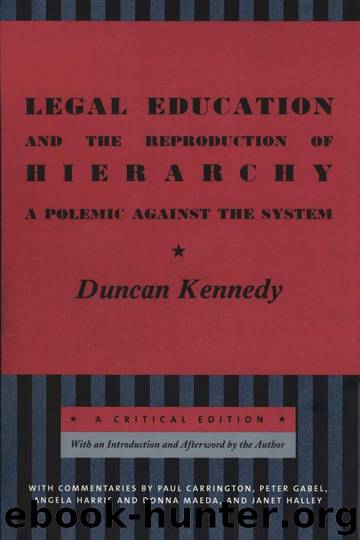Legal Education and the Reproduction of Hierarchy by Unknown

Author:Unknown
Language: eng
Format: epub
Published: 2020-02-22T16:00:00+00:00
NOTES
1. This is a comment on DUNCAN KENNEDY, LEGAL EDUCATION AND THE REPRODUCTION OF HIERARCHY: A POLEMIC AGAINST THE SYSTEM (Cambridge, 1983) prepared for inclusion in a republication of that essay by the New York University Press.
2. I have read an account of the Yale Law School of that era written and soon to be published by Laura Kalman. She made helpful comments on an earlier draft of this comment.
3. In 1970, I was assigned to serve as a hearing officer for the University of Michigan Graduate School to consider the cases of students who had disrupted a mathematics class. The leader of the disrupters was a graduate student in chemistry. (I fined him $100; he dropped out rather than pay it.)
4. Letter to R. Rosenwald, May 13, 1927, quoted in, JACK & JACK, MORAL VISION AND PROFESSIONAL DECISIONS 156 (Cambridge UK, 1989).
5. THE BLANK SLATE: THE MODERN DENIAL OF HUMAN NATURE (New York, 2002).
6. All the stories in that celebrated novel were circulating at the Harvard Law School in 1952, when I was a first-year student. It is not unlikely that many of them had gained color from frequent repetition. The novelist used all but one of the stories I heard. The one he did not use was my favorite. It was reported that a student was so agitated after reading the Property examination questions to which he had to respond that he drank his ink. He was taken to a convenient nursing station where the ink could be pumped out of his stomach. As he was returning to consciousness, the Bull entered the nursing station and asked him how he was feeling. “Okay, I guess, Professor Warren.” “That’s good,” the Bull was alleged to have said, “because you have only forty-five minutes to finish the exam.”
7. EDWARD H. WARREN, SPARTAN EDUCATION (Boston, 1942).
8. Acheson wrote four volumes of autobiography and he is the subject of five biographies.
9. He argued that lawyers sometimes have a duty to lie in Ethics of Advocacy, 4 STAN. L. REV. 3 (1951). A response is Henry Drinker, Some Remarks on Mr. Curtis, 4 STAN. L. REV. 349 (1952).
10. Ex parte Quirin, 317 U.S. 1 (1942).
11. American Freedom and the Law: Fighting the Communist Menace, 40 A.B.A.J. 559 (1953).
12. For comment on that change, see PAUL HASKELL, WHY LAWYERS BEHAVE AS THEY DO (Boulder, 1998).
13. On Ranking, J. LEG. ED. (forthcoming 2003).
14. For a brief account, see Paul D. Carrington, The Revolutionary Idea of University Legal Education, 31 WM. & MARY L. REV. 527 (1990).
15. PAUL D. CARRINGTON, STEWARDS OF DEMOCRACY: LAW AS A PUBLIC PROFESSION 25–34 (Boulder, 1999).
Download
This site does not store any files on its server. We only index and link to content provided by other sites. Please contact the content providers to delete copyright contents if any and email us, we'll remove relevant links or contents immediately.
Master of the Game by Sidney Sheldon(2209)
GRE Premier 2017 with 6 Practice Tests by Kaplan(1780)
Law School Essays that Made a Difference by Princeton Review(1739)
Law: A Very Short Introduction by Raymond Wacks(1660)
A Life of Crime by Harry Ognall(1618)
Objection! by Nancy Grace(1597)
Philosophy of law a very short introduction by Raymond Wacks(1577)
Examples & Explanations: Administrative Law by William F. Funk & Richard H. Seamon(1577)
College Essays that Made a Difference by Princeton Review(1575)
Writing to Win: The Legal Writer by Steven D. Stark(1516)
Cracking the SAT Premium Edition with 6 Practice Tests, 2017 by Princeton Review(1508)
GMAT For Dummies by Lisa Zimmer Hatch & Scott A. Hatch(1467)
Civil Procedure (Aspen Casebooks) by Stephen C. Yeazell(1462)
Sidney Sheldon (1982) Master Of The Game by Sidney Sheldon(1449)
Drafting Contracts: How and Why Lawyers Do What They Do, Second Edition by Stark Tina L(1428)
Storytelling for Lawyers by Meyer Philip(1381)
So You Want to be a Lawyer by Lisa Fairchild Jones Esq(1353)
Graduate Admissions Essays, Fourth Edition: Write Your Way into the Graduate School of Your Choice by Donald Asher(1332)
INDEFENSIBLE: One Lawyer's Journey Into the Inferno of American Justice by Feige David(1211)
